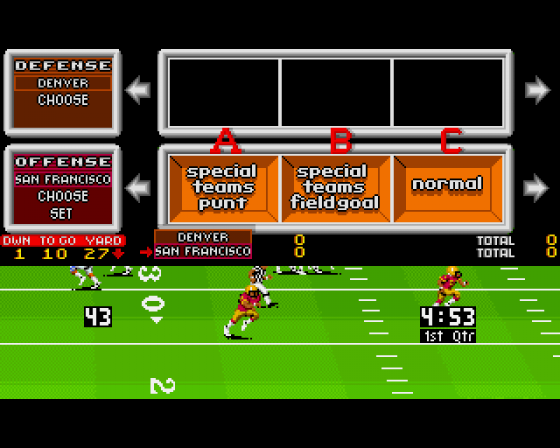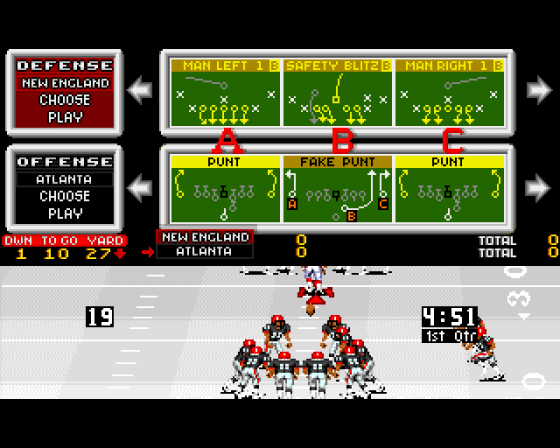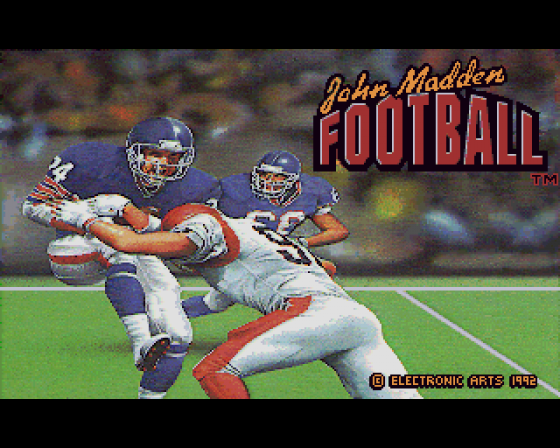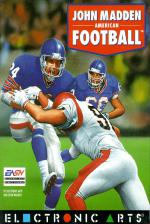
Amiga Power
 1st March 1992
1st March 1992
Author: Neil West
Publisher: Electronic Arts
Machine: Amiga 500
Published in Amiga Power #11
It may still be something of a minority interest, but the arrival of John Madden Football could be just the thing to have us all talking touchdowns in no time...
John Madden Football
Let's get one thing straight from the very beginning. John Madden Football on the Mega Drive is in my opinion probably the best computer game ever written. This, then, is for my money the most eagerly awaited Amiga release of the year. Does that make me biased? Maybe, but if EA have in any way failed to maximise the potential of this version then rest assured I'll let you know.
That's that off my chest - now let me introduce you to a man called John Madden and his American Football game. John Madden is one of the big footy commentators in the States (like Jimmy Hill, but infinitely more hip). But his biggest claim to fame is having coached the Oakland Raiders to a Superbowl victory years ago.
The game itself is also an award winner, having been voted 'video game of the year' at the 1990 InDin awards - a prize perhaps less high-profile than a Superbowl victory, but more relevant to our concerns. This is the game that took the Mega Drive owning world by storm (before a certain blue and white spiky speed-merchant hedge-hogging the limelight) and is now the first major Sega console game to be converted to home computer format. So let's take a look and see what's what...

First stop, the options screen. If there's two of you, you can play head-to-head. Alternatively, choose to field any one of seventeen football teams in either a regular season game, the first round of play-offs or a sudden death first-person-to-score grudge match against the computer.
Although you won't recognise the names as genuine NFL teams, each is unique. Although you only ever see 11 men from each team on the pitch at any one time, the squad consists of 45 individual players - each with his own particular strengths and weaknesses. These are reflected in a complete catalogue of player stats which are not only used as input data for the game's copy protection scheme, but combine to shape and mould the abilities, potential and perculiarities of each particular team.
It is in this way that you can tailor the difficulty of playing John Madden Football. Start off by representing a San Francisco or New York collection of hard nuts against a weaker team such as the (quite frankly, weedy) boys from Kansas City. You could even elect to field the All Madden team - a practically unbeatable, rootin' tootin', run-and-shootin', jock-strappin' posse of superheroes if ever there was one. Then, once you feel confident enough, play more evenly matched games.
Play Away, Or Even At Home

Now choose if you want your elected team to play home or away, inside under a dome or in the open air, on grass or astroturf, in fair weather, raain and mud or snow and ice. All these options will affect the ensuing game. Players will speed up or slow down - in ice or mud a running game becomes more difficult - and so on. Finally (after a brief character assassination of each team by a digitised image of John Madden himself) the crowd roars, the visiting team run onto the pitch and we're ready for kick-off.
This is your first glimpse of the pitch, and what a fine, 3D-rotating, scrolling spectacle it is too. A whistle blows, the visiting team's kicker runs up to the ball and wellies it down the pitch...
It is at this point that all hell breaks loose and (unfortunately) we're going to have to divide into two groups - those who already understand American Football perfectly, and those who haven't got the foggiest idea what those ridiculous Yanks have got against good old-fashioned rugger anyway.

There's no space really to explain all the rules and technicalities of the game but, suffice to say that John Madden Football pretty much knows that all. Just play a few games, concentrate on what's going on and pretty soon you'll learn how it works yourself.
Actually, there's a better idea - for the first few goes leave your joystick or keyboard (you can choose your control method at the start of the game) well alone, and let the computer play for you. Whether on offence or defence, if you don't make a choice of play within a time limit the computer will make your choice for you, then execute the moves with calculated efficiency - albeit with a distinct lack of "Oh my God, what the hell's going on?" sort of flamboyancy.
When you feel confident enough, you can start calling your own plays. You can then either join in the proceedings or (once again) let the computer do all the dirty work for you.
Get Madden, Then Get Even

While on offence, you start off playing the part of quarterback - you call the plays. Then, as soon as the action starts, you're put in direct control of whoever gets the ball. You can dive, spin or run around in circles - it's up to you. As with the play-selection sequences, you can choose to adopt a hands-off stance and let the computer get on with it itself if you'd rather.
But firstly, you must decide on a plan for the play. Facing up the pitch (John Madden Football always offers you a nice view of the quarterback's pert behind), once you've decided what you want to do (based on a quick study of the current state of the game, your team's strengths and your opponent's weaknesses) you're given control of three variables.
The New Leader In Its Field
First off, you have to decide which set of players you want on the field. There are six different sets (two of which are 'special' kicking teams), each suited to different plays. The favoured set of guys run onto the pitch, and you must then select one formation (from a possible five) for them to move into at the line of scrimmage. Again, some formations favour running plays, some passing. Some offer the quarterback plenty of protection - allowing him a few more precious seconds of time to decide what he wants to do after the snap - while others offer different benefits. There are plenty of variations.

Lastly, you must select a play from the six on offer. All with fancy names such as 'Down And Out', 'Cross Pass' or 'Half Back Screen', there will be a mixture of running and passing plays, weighted in favour of whatever suits the selected formation best. The players move into positions, a voice calls "set" and it's time to see if all your careful planning yields any benefits.
I Shall Say This Only Once
Sounds complicated? Don't worry - you'll soon get the hang of it. But what it does boil down to is a huge selection of 120 (four sets, each with five possible formations, in turn with its own selection of six plays) combination at your disposal. But even then your options are still open. You have the choice of rushing with the quarterback, calling an 'audible' (abandoning your planned play and running with a pre-defined set play) or whatever - not forgetting the decision to be taken on which of your three receivers you're going to pass to.
Sounds a lot? We haven't even talked about punts, field-goals, on-side kicks, time-outs, fumbles, interceptions, touchbacks or conversions yet...
While in defence, you're faced with an equally daunting array of options and possibilities. Experimentation is the only way to learn what works and what doesn't. You can decide which player to control before the snap (the player you control is standing on a cross so you can recognise him - even with his helmet on), and then swap to controlling whoever's in the thick of the action once the action starts.
If your opponent's quarterback manages to get a pass away, then a tap of the fire button swaps your control to the player nearest your opponent's receiver. You can then jump to intercept or bat down the ball or tackle the receiver (but be careful not to get penalised for pass interference).
So is this Amiga version of my previous fave game the classic conversion I was so dearly hoping it was going to be? I'm pleased to say that the answer is yes. The graphics are excellent - although there is occasionally slight slow-down - and the sound effects and sampled speech are as good as anything else I've ever heard. But, perhaps most importantly, the tricky job of maintaining the game's controllability while switching from a three-button joyspad to a one-button joystick has been handled as if it were never going to be a problem.
A Question Of Game Tactics
But still, the real hook is the game underneath the gloss - there's just so much here. If all the options, decisions, choices and permutations that I attempted to outline earlier sound daunting, then take it merely as an indication of John Madden Football's colossal depth. I played the Mega Drive version of this game solidly for around six months - and still came nowhere near to exploring everything that there was on offer.
Practise playing against the computer with one particular team and you'll soon find yourself able to beat all the opposition with ease. But then start fielding a different team (with different strengths and weaknesses) and you'll find yourself back to square one.
Better still, play against a human opponent. There are so many routes of discovery, so much scope for developing your own individual style of play, that no two people will ever find themselves having taken the same path to mastering the game. Hence no two players will ever (ever) find themselves not surprising (and in turn being surprised) with or by the plays and tactics that the other regarded as standard stuff.
Surely there has never been a game that demands so much of the player, in terms of both hands-on, adrenalin-pumping, pure arcade action and strategical thinking (don't underestimate this - third and two, three points behind, on the six yard line with twenty seconds on the clock with no time outs remaining is nothing less than a situation of grandmaster chess complexity).
That this is the Amiga's best ever American Football game ever is without question - I'm talking about higher stakes. For my money, and I'll accept that different people like different things, this game offers more than anything else I've ever seen, John Madden Football is quite possibly the most complete Amiga game you'll ever have the joy of playing.
The Bottom Line
Uppers: Superb graphics and sound are merely icing on the cake of a game that could possibly last you a lifetime. There's simply so much to explore and experiment with as your skills develop, playing against a human opponent will make every other two-player game you ever played seem shallow by comparison.
Downers: The computer opponents soon prove to be a walkover, so in the long run you'll find enjoyment limited to two-player action. John Madden '92 (the sequel) recently released on the Mega Drive offers more, but to criticise this Amiga version for lacking an upgrade's improvements seems facetious.
A near-perfect conversion of 1990's 'videogame of the year', with the only tweaks designed to improve on an already classic game. Two-player action is the key to unlocking this game's huge potential, so play with a partner. Graphically superb with glorious sound, John Madden Football looks as good as it plays.











